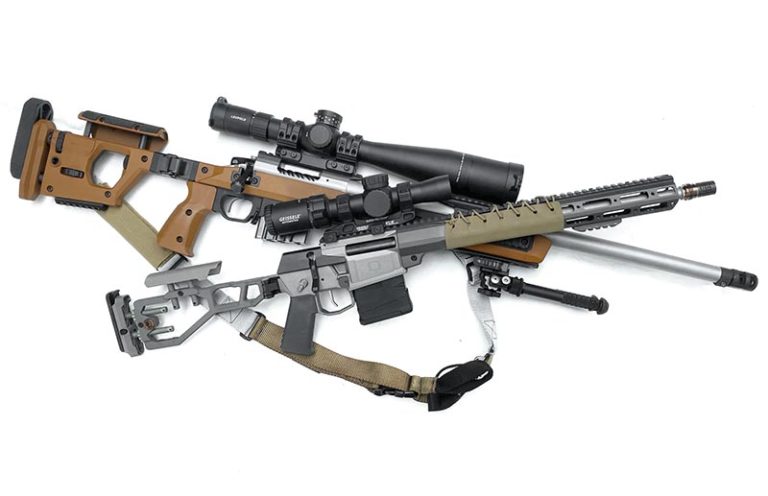
Just how tightly are rifle weight and rifle accuracy interwoven?
Today’s practical rifle is seldom its namesake. Frank Galli wrote a great column in these pages in the June 2021 issue titled Practical Precision, and he details the desire to return to what he called the “fighting rifleman,” where he criticizes the trend toward tournament and series-style events and begs returning to a hunting-style approach with rifles a man might carry into the field. He’s careful to say that innovations coming from the former have been beneficial but, in his view, unrealistic or unable to translate to the world at large.

I don’t necessarily believe that the weight of a rifle immediately determines its usefulness, as the 12-pound .338 Lapua is going to be a bit of a different story than a 12-pound .22 LR. Based directly on my practical experience, I think that physical balance (center of gravity) and a pairing of weight-to-cartridge is overlooked, to the detriment of many riflemen.
The main argument for a practical rifle should be that it, at a bare minimum, is able to be carried easily and pointed naturally. Rifle shooting in competition has become something of a supported, stationary event that favors extremely heavy guns that bear virtually all their weight in the barrel. Since hits are all that matter, even energy on target is an afterthought.
So, how do we get back to a practical rifle in weight, balance and cartridge, knowing that most of what’s out there today is trending to the games that favor puny bullets fired from boat anchors?
The first thing to do is start with the cartridge and go from there.
Caliber, Weight and Balance
The first hurdle to selecting a practical rifle is deciding what exactly you want to shoot with it. Finding the sweet spot between balance, accuracy and cartridge is a challenge in some respects and gets more challenging as you move up in power, where weight is needed to absorb recoil.
For me, the 6.5 Creedmoor can do what I need it to do for 95 percent of my hunting and match uses. I’m competitive at 1,000 yards but also able to hunt large game. I get an edge over the .308 Win. for target shooting and am equally capable on most American game inside 500 yards—a distance I consider to be the maximum for myself in real terms and the distance to which I believe that the cartridge is at its most effective.
Knowing that I’m going with the 6.5 Creedmoor, let’s look at four 6.5mm rifles I have and just what my round of choice does well. Each of these rifles is designed for a specific purpose, and only one I consider to be the definition of practical for all general use.
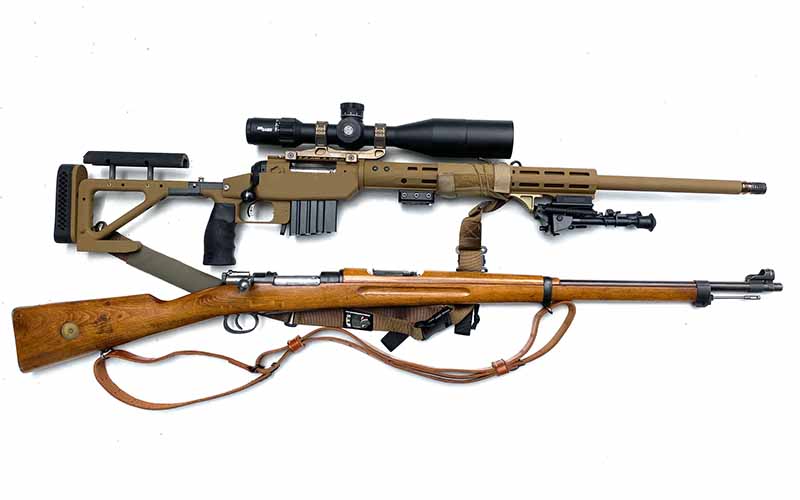
Custom Savage 110 MK4 Mod7
The tan-colored Savage action in a custom chassis is a competition rifle I built myself. The barrel is 26 inches long, and I can fire 140s loaded hot at 2,900 fps. It’s 19 pounds as pictured and is balanced for me to be able to make offhand shots. Note that my comb and stock on this gun are set for me: Length of pull is short at 12 inches and the Sig optic sits quite far forward to account for offhand head placement. The center of gravity for this rifle is at the tripod interface. It’s a rifle that I consider too heavy for field hunting use, but just about ideal for non-static shooting.
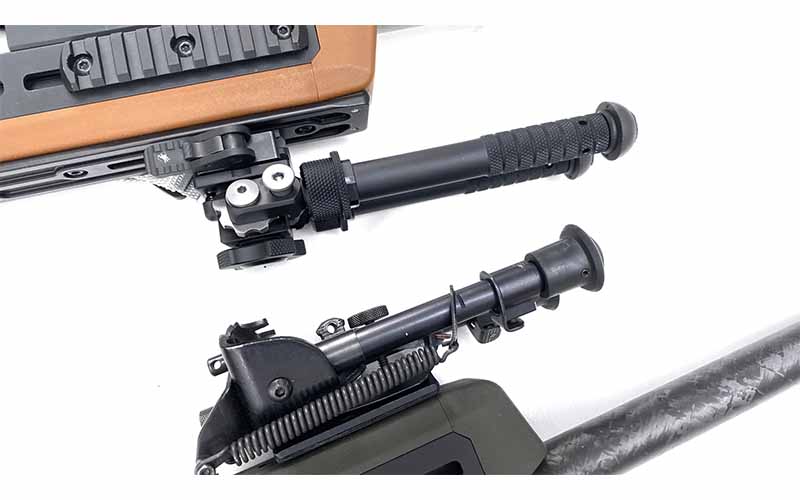
Tuebor Legion Titanium
My pick for a true practical rifle is this build. Coming in at 13 pounds, it has all the same ergonomics but is just over half the weight of the tan Sweet Potato Tuebor discussed below. This is the type of rifle that I could carry afield with ease. The gun recoils quite a bit more than the heavy target 6.5s, but the balance is right at the recoil lug, making it easy to shoot from offhand or with limited support.
It’s something of an overdressed modern hunting rifle. The balance alone makes it much easier to use, as the support needed to deploy it into action is minimal. The Magpul Pro 700 chassis is a bit bulky; however, the rifle as a whole strongly benefits from its adjustability. I’d say that as far as overall practicality for all-around use, the 24-inch Proof carbon-fiber barrel and titanium action save enough weight to justify a large USO scope and folding chassis. The rifle is set up for any use, is powerful enough for hunting, light enough for carry and accurate enough for matches.
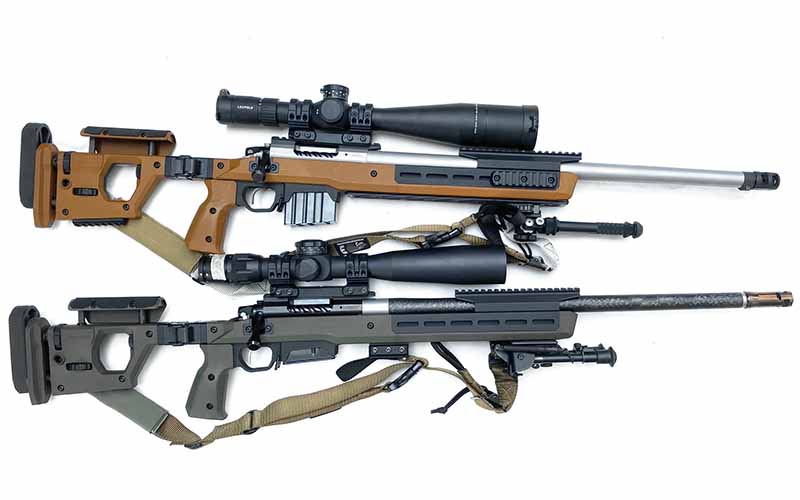
Sweet Potato
The tan Tuebor Precision is lovingly referred to as the Sweet Potato. It’s heavy at 21 pounds with a 24-inch M24 contour Brownells Premium barrel. Balance? You’re kidding. If you look up front-heavy in the dictionary, you’ll find Sweet Potato right there. The rifle is meant for stationary proposition open-field hunting off a tripod. It’s extremely accurate, firing Federal 130-grain Berger factory loads in 6.5 CM into one hole at 100 meters. It’s heavy enough that I don’t consider it to be practical in a real sense; in no way is it a walking or stalking rifle. Offhand or a hasty field shot is extremely difficult.
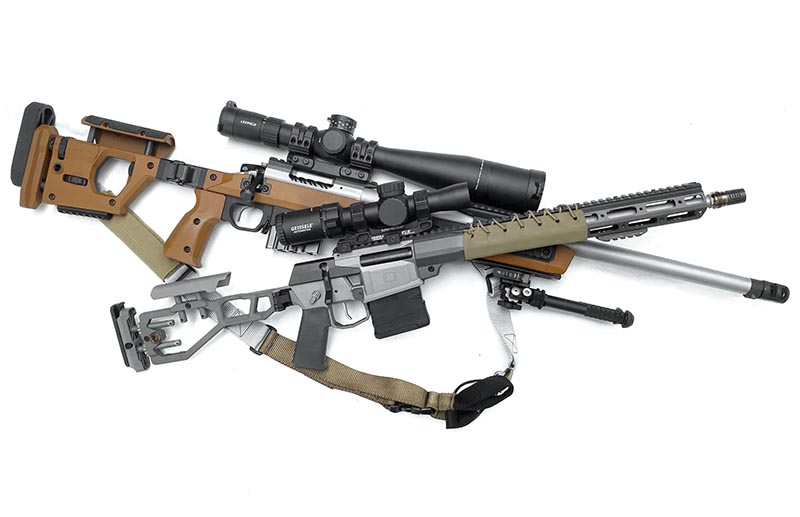
The Q Fix
Dropping to half that in weight is another 6.5 CM, this time the 16-inch The Fix from Q, also the subject of its own article. At 6.4 pounds without optics, it’s super light for an all-metal rifle. It’s minimalistic and utilitarian, and even with optics, it’s difficult to make it crack 8 pounds. It, with a full set of accessories including bipod and sling, is still in the 7.5-pound range.
This type of rifle is very accurate; however, the lack of mass becomes noticeable in terms of recoil quickly. To put it in context, three of these rifles would add up to one Sweet Potato. The balance in this rifle is in the action, making it very fast to point and easy to shoulder quickly. It’s quite ideal for hunting at short to medium range.
Realities of Weight, Balance and Rifle Accuracy
It’s not really important what your gun does at the range: If you can hold 1 to 2 MOA in the field after walking miles, spotting game and overcoming adrenaline, you should probably be writing this not me. Field shooting with “real” rifle calibers isn’t easy in the slightest. What you see in the games result in no consequences; there’s no wounded animals, no moral obligations to finish a chase and no downside to using a small bore with low mass and energy. Hell, you usually don’t even have recoil to worry about.
I like a rifle with more weight than The Fix. Most of my own hunting rifles are in the 10-pound range, and I like it that way because I’ve never once had a textbook shot present itself where I was able to address it with textbook stability. For me, a 13-pound 6.5 CM is just about where it’s at for all-around use including shots from offhand.
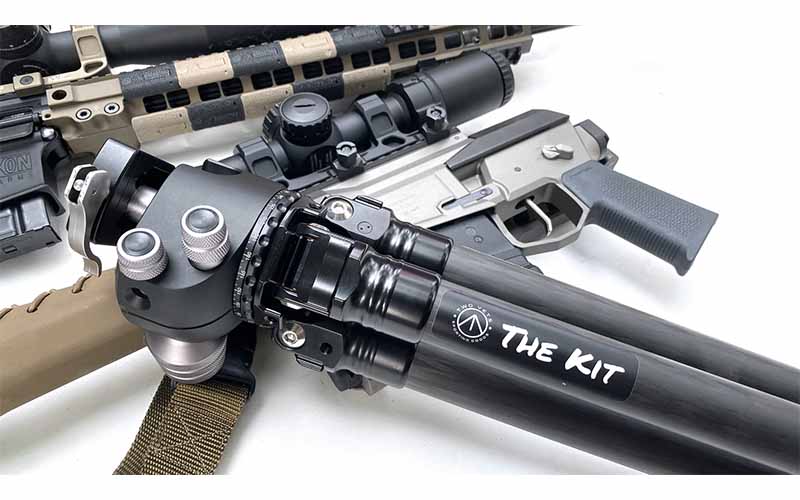
If I was out hunting with a rifle like The Fix, weight is already my main concern, and I’d be knowingly sacrificing some range and steadiness. You may say, “Josh, set up for your shot, you novice.” However, I’ve been out of breath for more shots than I can remember, not counting cold and hungry. Plenty of hunters I know get the shakes or can’t hold steady, and a lighter gun won’t help any more than one that’s unbalanced.
Can Small-Bore Rifles Be a Practical Choice?
I don’t want you to come away with the impression I’m only going to disparage small-bores; it’s only that I don’t want to agree with the sentiment that a 25-pound 22 BR with a 28-inch bull barrel is somehow a practical or pragmatic choice. The trend to increase weight and reduce caliber is simply a matter of gamesmanship that drives a competitive edge. In all fairness, you can do great with a heavy gun shooting slippery 90-grain bullets out of a .22 bore in terms of making hits. This is part of a specific game that shouldn’t be misconstrued with a field-use rifle. That said, a .22 bore has plenty of use, just on small game at medium distance.
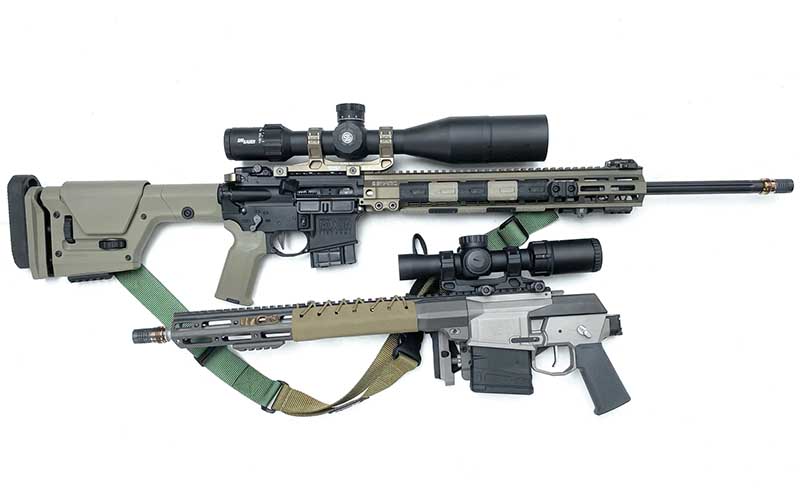
One of the most practical and well-balanced rifles I have is a 22-inch medium weight .224 Valkyrie, coming in at 12 pounds fully kitted out. This is somewhat heavy for an AR, but it shoots 1/2 MOA at 100 meters and can be fired from the shoulder offhand with great accuracy. This rifle is well-balanced, with the center of gravity being low and just ahead of the magwell. It’s superb out to 800 yards and duplicates the trajectory of my 6.5 Creedmoors using the Federal 80.5-grain factory match load. It has some recoil, but not much.
The AR platform is extremely modular and is probably the easiest rifle type to balance out for offhand or poorly supported shots. As pictured on the .224 Valkyrie build, I use a medium weight barrel and a heavy Magpul PRS stock, thus making the rifle sit comfortably in the shoulder without strain on the support arm.
I really like this rifle because it’s fun to shoot. However, in terms of real use, I’d probably never take it after anything other than coyote or small pigs. It has utility as a deer rifle for small individuals, but I don’t know any hunters who are using the .224 Valkyrie on deer, though it’s a young cartridge. Federal makes a 90-grain soft point that should work well on whitetail at closer ranges and give a similar effect to .243 Win. inside 200 yards.
Small-bore rifles are lots of fun to use and can cut out the bite of recoil; however, there’s little meaningful energy for them to be truly called practical at any distance beyond 300 yards, which is even sketchy for some common hunting rounds.
I hear all the time of 700- and 800-yard shots with 6mm and .22 bore rifles, but I rarely see those hunters bring home as much game as I do with a .450 Bushmaster and .45 ACP at close range. Hitting them isn’t usually the problem, but killing or even finding them is another story. I’d never, regardless of rifle, take a shot on a deer-sized animal with a .22 bore or 6mm at any distance beyond 200 yards and that, I believe, is the true Achilles’ heel of the small-bore rifle.
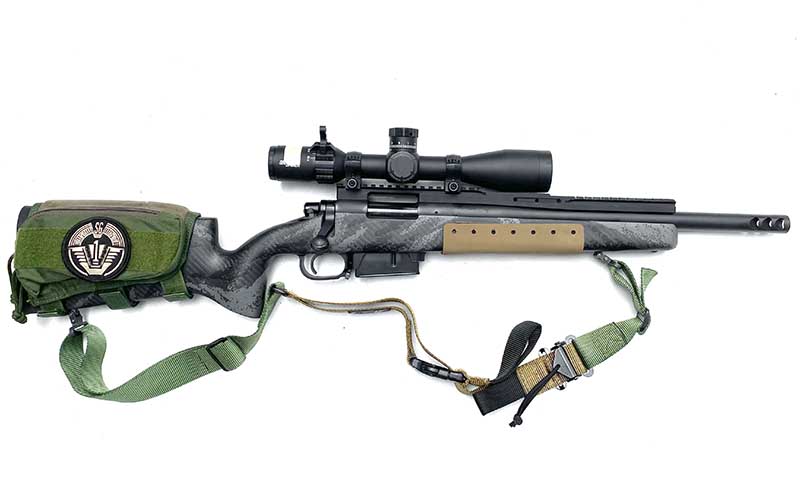
Conclusion
In returning to the “fighting rifleman,” as Galli says, the most difficult thing in our day is wading through the mire of available options to find what works best as a do-all rifle—something that I feel is in the vein of Jeff Cooper’s scout rifle or a military “Recce” rifle. Small-bores have their place.
A rifle, however, must be the sum of not just its parts, but how those parts are assembled and in what caliber. That is, at least to me, not something you’ll find with anything too small to reliably knock over a plate at 500 yards.
Editor's Note: This article originally appeared in the November 2021 issue of Gun Digest the Magazine.
More On Rifle Accuracy:
- Precision Rifle Upgrades: From Stock To Sniper Superstar
- Nine Long-Range Shooting Fundementals To Master
- Accuracy Enhancing Support: Choosing A Bipod
- Legacy Skills: Becoming A Well-Rounded Long-Range Marksman
- Becoming Your Own Spotter

Next Step: Get your FREE Printable Target Pack
Enhance your shooting precision with our 62 MOA Targets, perfect for rifles and handguns. Crafted in collaboration with Storm Tactical for accuracy and versatility.
Subscribe to the Gun Digest email newsletter and get your downloadable target pack sent straight to your inbox. Stay updated with the latest firearms info in the industry.

![Best Concealed Carry Guns In 2025 [Field Tested] Wilson Combat EDC X9S 1](https://gundigest.com/wp-content/uploads/Wilson-Combat-EDC-X9S-1-324x160.jpg)


![Best 9mm Carbine: Affordable PCCs [Tested] Ruger Carbine Shooting](https://gundigest.com/wp-content/uploads/Ruger-Carbine-Shooting-100x70.jpg)
![Best AR-15: Top Options Available Today [Field Tested] Harrington and Richardson PSA XM177E2 feature](https://gundigest.com/wp-content/uploads/Harrington-and-Richardson-PSA-XM177E2-feature-100x70.jpg)
